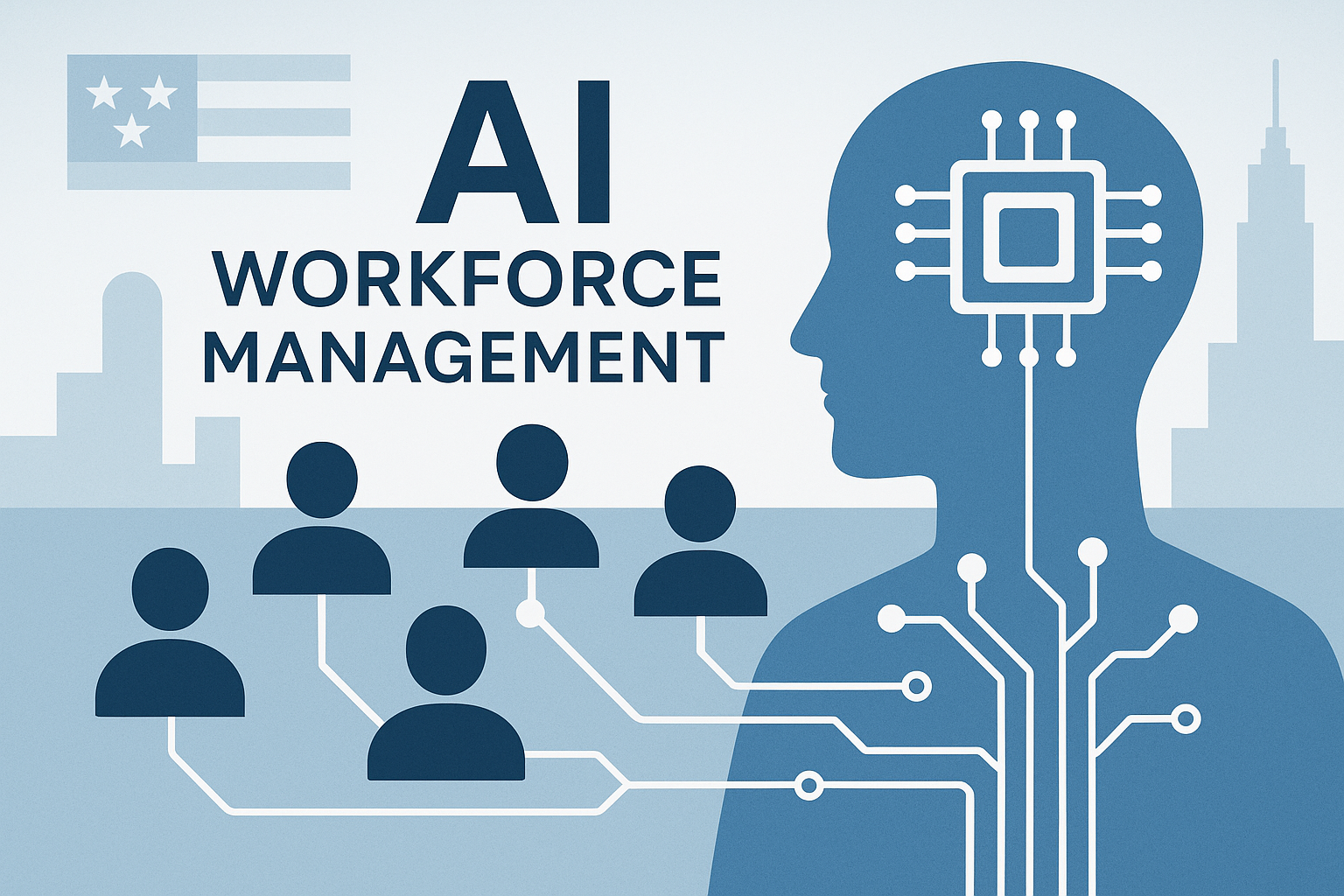
AI in Workforce Management: Transforming U.S. Businesses in 2025
Artificial Intelligence (AI) is revolutionizing how American companies manage their teams, optimize productivity, and stay competitive. In 2025, AI in workforce management is no longer a futuristic concept—it’s a practical necessity for organizations of all sizes. This comprehensive guide explores the latest trends, benefits, challenges, and top AI tools shaping workforce management across the United States.
What Is AI in Workforce Management? Understanding the 2025 Landscape
AI in workforce management refers to the integration of artificial intelligence technologies into processes like scheduling, recruitment, performance analysis, and employee engagement. These intelligent systems analyze vast amounts of data, automate repetitive tasks, and provide actionable insights to HR professionals and business leaders.
Key Components of AI-Driven Workforce Management
- Automated Scheduling: AI algorithms optimize shift assignments, reduce overtime, and ensure compliance with labor laws.
- Predictive Analytics: Machine learning models forecast staffing needs, turnover risks, and productivity trends.
- Talent Acquisition: AI streamlines candidate screening, shortlisting, and onboarding.
- Employee Engagement: Intelligent platforms monitor sentiment, suggest training, and personalize development plans.
TIP: Embracing AI in workforce management can help U.S. companies reduce costs, improve employee satisfaction, and gain a competitive edge.
Top 10 AI Workforce Management Tools in the U.S. (2025 Edition)
Choosing the right AI-powered solution is crucial for maximizing efficiency. Here are the top 10 AI workforce management tools dominating the U.S. market in 2025:
- Workday AI
- UKG Pro (Ultimate Kronos Group)
- ADP Workforce Now AI
- Ceridian Dayforce Intelligence
- Oracle HCM Cloud AI
- SAP SuccessFactors AI
- BambooHR AI
- Zoho People AI
- Paycor AI
- Rippling AI
Side-by-Side Comparison Table
| Rank | Tool Name | Best For | Key AI Features | U.S. Market Presence |
|---|---|---|---|---|
| 1 | Workday AI | Enterprises | Predictive analytics, chatbots | Very Strong |
| 2 | UKG Pro | Large organizations | Automated scheduling, insights | Strong |
| 3 | ADP Workforce Now AI | Mid-large businesses | AI recruiting, compliance | Very Strong |
| 4 | Ceridian Dayforce | Payroll & compliance | Forecasting, automation | Strong |
| 5 | Oracle HCM Cloud AI | Global enterprises | Talent management, analytics | Strong |
| 6 | SAP SuccessFactors AI | Multinationals | Performance, engagement | Strong |
| 7 | BambooHR AI | SMBs | AI onboarding, analytics | Growing |
| 8 | Zoho People AI | Small businesses | Automation, sentiment analysis | Growing |
| 9 | Paycor AI | Payroll-centric firms | Scheduling, analytics | Moderate |
| 10 | Rippling AI | Startups & tech firms | Workflow automation | Growing |
Benefits of AI in Workforce Management for U.S. Companies
Implementing AI in workforce management delivers measurable advantages:
1. Enhanced Productivity 📈
AI automates repetitive HR tasks, freeing up managers and employees to focus on strategic work.
2. Improved Decision-Making 🧠
Data-driven insights help leaders make smarter staffing, scheduling, and development decisions.
3. Cost Savings 💵
Optimized scheduling and reduced overtime translate into significant payroll savings.
4. Better Compliance ✅
AI systems monitor labor laws and flag potential violations, reducing legal risks.
5. Superior Employee Experience 😊
Personalized engagement and development plans boost morale and retention.
TIP: According to 2025 U.S. workforce studies, companies leveraging AI in workforce management report up to 30% higher employee satisfaction rates.
Challenges and Considerations When Adopting AI in Workforce Management
While the benefits are compelling, U.S. organizations must navigate several challenges:
Data Privacy and Security 🔒
Handling sensitive employee data requires robust security protocols and compliance with regulations like CCPA.
Change Management and Training 📚
Employees and managers need training to adapt to new AI-driven workflows.
Integration with Legacy Systems 🔗
Seamless integration with existing HR and payroll systems is essential for success.
Ethical and Bias Concerns ⚖️
AI algorithms must be monitored to prevent bias in hiring, promotions, or performance evaluations.
TIP: Regular audits and transparent AI models help mitigate bias and build trust among employees.
Real-World Applications: How U.S. Businesses Use AI in Workforce Management
Automated Shift Scheduling for Retail Chains
Large retailers use AI to predict customer traffic and optimize staff schedules, reducing labor costs and improving service.
AI-Powered Recruitment in Tech Firms
Tech companies leverage AI to screen thousands of resumes, identify top talent, and accelerate hiring.
Predictive Turnover Analysis in Healthcare 🏥
Hospitals use AI to forecast nurse turnover, enabling proactive retention strategies and better patient care.
Personalized Learning Paths in Finance
Financial institutions deploy AI to recommend training modules tailored to each employee’s career goals.
Future Trends: The Evolution of AI in Workforce Management (2025 and Beyond)
- Conversational AI: Virtual HR assistants handle employee queries 24/7.
- Emotion AI: Systems analyze employee sentiment from emails and feedback.
- Hyper-Personalization: AI crafts individualized career and wellness plans.
- Real-Time Analytics: Instant dashboards for workforce optimization.
TIP: Staying ahead of AI trends ensures your organization remains agile and competitive in the evolving U.S. labor market.
Conclusion: Why AI in Workforce Management Is Essential for U.S. Businesses in 2025
AI in workforce management is transforming how American companies recruit, schedule, engage, and retain talent. In 2025, embracing AI-driven solutions is not just about efficiency—it’s about building a resilient, future-ready workforce. The top tools offer automation, predictive insights, and personalization, while the benefits range from cost savings to improved employee satisfaction. However, organizations must address challenges like data privacy, integration, and ethical AI use to realize the full potential of these technologies.
By strategically adopting AI in workforce management, U.S. businesses can unlock new levels of productivity, compliance, and employee engagement—securing their place at the forefront of the modern economy.